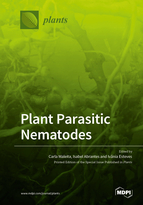Plant Parasitic Nematodes
A special issue of Plants (ISSN 2223-7747). This special issue belongs to the section "Plant Protection and Biotic Interactions".
Deadline for manuscript submissions: closed (1 December 2021) | Viewed by 38061
Special Issue Editors
Interests: natural compounds from agricultural residues/byproducts and plant extracts/essential oils to be used in the management of emerging and concomitant plant-parasitic nematodes (PPN); bionematicide formulations; evaluation of the ecotoxicological effects of bionematicides in plants and soil invertebrates, including non-target soil nematode communities; assessment of the effects of phytocompounds in PPN life cycle and genes expression profiles; characterisation of the molecular mechanisms involved in plant-nematode interaction that contribute to pathogenesis and defence response in plant host against RKN species; assessment of the pathogenicity of the root knot nematodes; morphological/biochemical/molecular characterisation of PPN
Special Issues, Collections and Topics in MDPI journals
Interests: new sustainable and eco-friendly strategies for the management of the economically most important plant-parasitic nematodes (PPN): development of alternative and innovative methodologies to obtain resistant plants; development of formulations based on phytochemicals; selection of genes related with the pathogenicity with potential to be used in the control of those PPN, identification of proteins, secreted by PPN involved in the penetration/ migration of the nematodes in the plant tissues and in the interaction with the host plants with different susceptibility to the infection
Interests: biocontrol agents and studies on the nematicidal activity of plant natural extracts as sustainable alternatives to chemical pesticides; development of quick diagnostic tools for the detection and identification of emerging species of plant-parasitic nematodes, molecular characterisation and host studies with root lesion nematodes; Pratylenchus spp.
Special Issues, Collections and Topics in MDPI journals
Special Issue Information
Dear Colleagues,
Plant parasitic nematodes (PPN) are economically important pests for numerous agriculture and forestry crops, representing a significant constraint on global food security and forestry health. Damage caused by these nematodes has been estimated at $US80 billion/year. However, this value is likely to be underestimated, as PPN are small plant/soil-borne pathogens, the symptoms that they cause are unspecific, and most of the growers are often unaware of their presence.
Root-knot nematodes (Meloidogyne spp.), cyst nematodes (Heterodera and Globodera spp.), root-lesion nematodes (Pratylenchus spp.), the burrowing nematode Radopholus similis, the stem nematode Ditylenchus dipsaci, and the pinewood nematode Bursaphelenchus xylophilus are some examples of PPN ranked at the top in the list of the most economically and scientifically important species.
Current approaches to control these PPN include the use of nematicides and/or unselective pesticides, but many synthetic chemical nematicides pose serious concerns for human health and the environment. To cope with such threat, accurate diagnostic methods for nematode detection and a deep understanding of nematode infection processes as well as of their intricate relationships with the host plants are crucial for the development of effective integrated nematode management programs.
This Special Issue on Plant Parasitic Nematodes aims to publish articles (original research manuscripts and reviews) that focus on diagnostics, detection, and surveillance of PPN associated with economically important agriculture and forestry crops, with a special focus on emergent PPN and quarantine species, improvement/optimization of PPN identification and detection methods, effect of abiotic factors on PPN survival and pathogenicity, identification of risks for PPN dissemination, knowledge of nematode–host interactions at physiological and/or molecular levels, and new sustainable and eco-friendly strategies for PPN management.
Dr. Carla Maleita
Prof. Dr. Isabel Abrantes
Dr. Ivânia Esteves
Guest Editors
Manuscript Submission Information
Manuscripts should be submitted online at www.mdpi.com by registering and logging in to this website. Once you are registered, click here to go to the submission form. Manuscripts can be submitted until the deadline. All submissions that pass pre-check are peer-reviewed. Accepted papers will be published continuously in the journal (as soon as accepted) and will be listed together on the special issue website. Research articles, review articles as well as short communications are invited. For planned papers, a title and short abstract (about 100 words) can be sent to the Editorial Office for announcement on this website.
Submitted manuscripts should not have been published previously, nor be under consideration for publication elsewhere (except conference proceedings papers). All manuscripts are thoroughly refereed through a single-blind peer-review process. A guide for authors and other relevant information for submission of manuscripts is available on the Instructions for Authors page. Plants is an international peer-reviewed open access semimonthly journal published by MDPI.
Please visit the Instructions for Authors page before submitting a manuscript. The Article Processing Charge (APC) for publication in this open access journal is 2700 CHF (Swiss Francs). Submitted papers should be well formatted and use good English. Authors may use MDPI's English editing service prior to publication or during author revisions.







